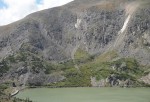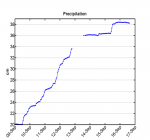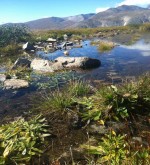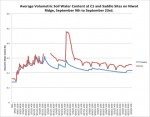It wasn’t all bad news up here on Niwot Ridge following what some local newspapers have dubbed the “1000 year rain”: the Long Term Ecological Research (LTER) program and our Mountain Research Station (MRS) emerged relatively unscathed from the scary floods. Between Tuesday September 10 and Monday morning September 16, the areas around Boulder, CO, received an historic 17.16 inches of rain. However rain amounts on Niwot, while well above normal, were not catastrophic and resulted in very little damage to roads, buildings, or research sites. Totals on the ridge ranged from 4.83 inches of rain at our D1 site located at 12,267 feet, 5.93 inches at the 11,500 foot Saddle station, and 7.48 inches at our C1 site located at 9,914 feet in elevation.
The heavy rains have increased stream flows and soil moisture to levels similar to spring snowmelt conditions. Alpine streams that have been dry since mid-July are flowing again, and mudslides can be seen in the City of Boulder watershed. In fact, Niwot looks like spring again, except with more Autumn-like colors and far less snow.
At the time of writing this story, the road above MRS to sites along Niwot Ridge is still completely drivable (though a little rough in sections), with the largest obstacle to work on Niwot being the damage to roads between the MRS and Boulder. However, almost all the roads between the mountains and plains in the area are closed, or open to emergency and local traffic only.
The flooding caused large debris flows to cover roads and undercut the highways through the mountain canyons. In some places bridges and roads were washed away completely, and the threat of new rock or mudslides on unstable canyon walls still remains. Initially, the Colorado Department of Transportation estimated that it would take at least a month before Boulder Canyon (the main thoroughfare between Boulder and the MRS) reopened, but they were able to finish earlier and reopen it on Monday, October 7. The closures had forced researchers at MRS into a two hour commute from Boulder, needing to drive about an hour south along the base of the foothills to where roads with mountain access remained open.
Notwithstanding the transportation issues, we feel very fortunate that all is well at the MRS and we are comparatively less affected by the damage from flooding in the Front Range. Our sympathies go to those who have lost much more than a convenient commute. On the plus side, Monday September 23 began with some of the first new snow of the year up on the ridge and winds were gusting above 70 miles per hour. That spells business as usual on Niwot.

 Enlarge this image
Enlarge this image



